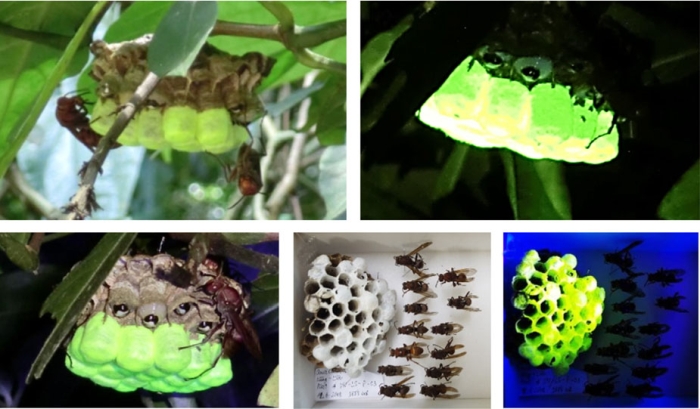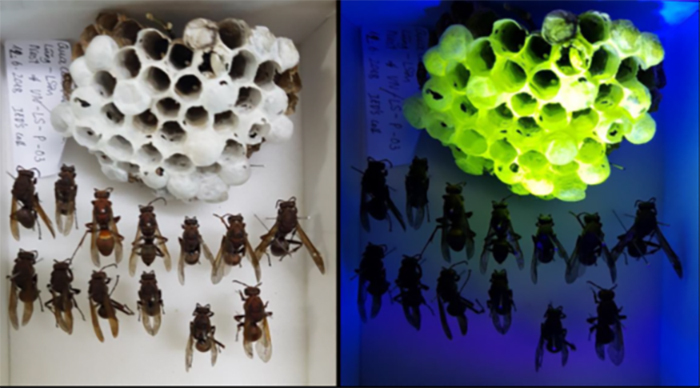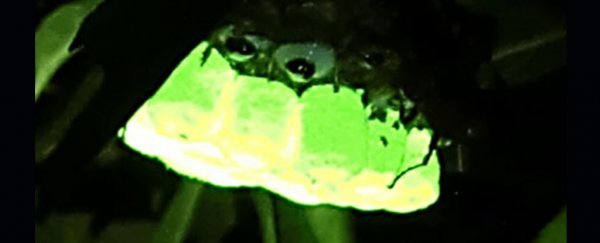Recently, we've been learning that the world is a much… glowier place than we ever suspected.
More and more terrestrial organisms have been found exhibiting biofluorescence - a soft, eerie, beautiful glow that we can see under ultraviolet light. Now the glow has been found somewhere even more unexpected - the segmented nests of several species of Asian wasps.
To varying degrees, the architectural stylings of several species of the genus Polistes glow brightly green under blacklight, strongly enough to suggest the fluorescence has a function, even though the wasps themselves show no sign of radiance.
This peculiarity could help scientists figure out why the nests glow - and could also help identify a new biofluorescent compound, like the green fluorescent protein marker derived from jellyfish that has become so vital to biological science.
The work was co-led by chemist Bernd Schöllhorn of the University of Paris in France, and physicist Serge Berthier from Sorbonne University; the team was hoping to uncover even more terrestrial biofluorescence.
"In the beginning I was searching for any strongly fluorescent animals in the tropical rain forests," he told ScienceAlert. "Personally, I was very optimistic to find interesting organisms, because this aspect still remains under-explored."
Biofluorescence is when a living organism or biomatter absorbs light, and re-emits it at a different wavelength. For a human to see this effect, the organism needs to be illuminated by an external light source, such as a UV light. It's been documented in a range of species, mostly marine - by quite a wide margin, actually.
Other organisms that biofluoresce include frogs, scorpions, chameleons, turtles, and, as was recently a huge surprise discovery, Australian marsupials such as wombats and platypuses. Who knows what else could be out there, secretly fluorescing in the dark?
This is the question the French and Vietnamese team went looking to answer - and they found it in the nests of four species, located during intrepid forays into the humid tropical forests of North Vietnam at night: Polistes brunetus, P. lepcha, P. japonicus and one unidentified Polistes species.
 Images of wasp nests fluorescing. (de Marcillac et al., J. R. Soc. Interface, 2021)
Images of wasp nests fluorescing. (de Marcillac et al., J. R. Soc. Interface, 2021)
"Visible fluorescence can best be revealed during the night, adding up a bit of adrenaline during the field trips," Schöllhorn said.
"One has to be experienced and cautious since many arthropods and reptiles can be potentially dangerous, including the hornets (wasps) themselves depending on the species and the situation."
The team compared their find against two Polistes species from other parts of the world: P. canadensis from French Guyana and P. gallicus from southern France, both of which fluoresced only weakly in comparison to the Vietnamese wasps.
 A P. brunetus nest under white (left) and UV light (right). (de Marcillac et al., J. R. Soc. Interface, 2021)
A P. brunetus nest under white (left) and UV light (right). (de Marcillac et al., J. R. Soc. Interface, 2021)
"The Vietnamese nests in this work could be spotted during the night, thanks to their inherent and strong greenish yellow fluorescence, with the help of portable UV LED torches," the researchers wrote in their paper.
"In the natural environment, the strong fluorescence can be easily observed with the naked eye at distances of 5 to 20 meters [16 to 65 feet] depending on the species, nest size and power of the UV torch."
Of particular note were the cocoon caps, which glowed the most brightly on all of the nests. Microscopy revealed fluorescence present specifically in the silk fibers, suggesting that fluorophores - that is, fluorescent chemical compounds - are likely present in the silk protein produced by the wasps.
The spectral range of the fluorescence emission is within the general range of wasp vision, although the team did not examine the vision of these particular species. If wasps can see the green glow, it could mean that the nests biofluoresce as a way for the wasps to recognize their homes (that may not be the case - two species exhibited very similar fluorescence profiles).
However, there is another tantalizing possibility: that the fluorescence is a means of protecting developing pupae from ultraviolet radiation. The incoming light is intercepted and converted to benign optical light that is then re-emitted. Since pupa development is dependent on the day-night cycle, biofluorescence could perform this function while allowing non-harmful light to penetrate the cocoon membrane.
The team is working to investigate other species of the same genus, to see how biofluorescence varies according to region. And, of course, they are now working to identify the fluorescent compound in the wasp silk, in the hopes of discovering a new source of biofluorescence for biomedical research.
"Most exciting to me is certainly the fact that 'out there' in the forest a plethora of unknown phenomena is still waiting to be discovered," Schöllhorn said.
The research has been published in the Journal of the Royal Society Interface.
